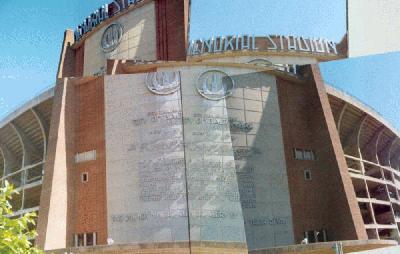Baltimore IMC : http://www.baltimoreimc.org
Production of Space, Destruction of Place, Erasure of Memory: A Photoessay on Stadiums in Baltimore
From Memorial Stadium to Camden Yards

STADIUMS & URBAN ECONOMY IN BALTIMORE
In the 1990s, $500 million of public funds were used to finance new stadiums for the Orioles and the Baltimore Ravens. Oriole Park at Camden Yards cost $100 million to construct. Politicians made the argument that such investments would create jobs and income for the City. Maryland Governor William Donald Schaefer, former mayor of Baltimore, aggressively lobbied in the 1980s for a baseball-only stadium. Legislators accepted the jobs and economic health arguments. On April 6, 1992, the new home of the Baltimore Orioles opened. The Maryland Stadium Authority, a public agency, is the owner.
In a 1997 study covering a five year period, Bruce Hamilton and Peter Kahn showed a net loss in the range of $11 million of public investment annually for Oriole Park at Camden Yards, or $14.70 per household regardless of interest in baseball. For the Ravens stadium, the annual deficit approximates $13 million. Thus, the new Baltimore sports stadium project costs the citizens about $24 million annually. In addition, the few jobs created by Oriole Park, about 500, result from the spending of out-of-state game attendees. These experiences are consistent with that of other cities. Yet, as Baltimore City and the State of Maryland supported the stadium projects, funding for libraries, public education, and urban services declined.
See Bruce Hamilton and Peter Kahn, "Baltimore's Camden Yards Ballpark," in Sports, Jobs, and Taxes: The Economic Impact of Sports Teams and Stadiums, edited by R. Noll and A. Zimbalist. Washington, DC: Brookings Institute, 1997. www.econ.jhu.edu/People/Hamilton/Camden.pdf .
For a general analysis on sports teams, stadiums and urban political economy see:
D. Stanley Eitzen, "Public Teams, Private Profits: How Pro Sports Owners Run Up the Score on Fans and Taxpayers," Dollars and Sense, Number 228, March/April 2000. www.dollarsandsense.org/2000/0300eitzen.html
In the 1990s, $500 million of public funds were used to finance new stadiums for the Orioles and the Baltimore Ravens. Oriole Park at Camden Yards cost $100 million to construct. Politicians made the argument that such investments would create jobs and income for the City. Maryland Governor William Donald Schaefer, former mayor of Baltimore, aggressively lobbied in the 1980s for a baseball-only stadium. Legislators accepted the jobs and economic health arguments. On April 6, 1992, the new home of the Baltimore Orioles opened. The Maryland Stadium Authority, a public agency, is the owner.
In a 1997 study covering a five year period, Bruce Hamilton and Peter Kahn showed a net loss in the range of $11 million of public investment annually for Oriole Park at Camden Yards, or $14.70 per household regardless of interest in baseball. For the Ravens stadium, the annual deficit approximates $13 million. Thus, the new Baltimore sports stadium project costs the citizens about $24 million annually. In addition, the few jobs created by Oriole Park, about 500, result from the spending of out-of-state game attendees. These experiences are consistent with that of other cities. Yet, as Baltimore City and the State of Maryland supported the stadium projects, funding for libraries, public education, and urban services declined.
See Bruce Hamilton and Peter Kahn, "Baltimore's Camden Yards Ballpark," in Sports, Jobs, and Taxes: The Economic Impact of Sports Teams and Stadiums, edited by R. Noll and A. Zimbalist. Washington, DC: Brookings Institute, 1997. www.econ.jhu.edu/People/Hamilton/Camden.pdf .
For a general analysis on sports teams, stadiums and urban political economy see:
D. Stanley Eitzen, "Public Teams, Private Profits: How Pro Sports Owners Run Up the Score on Fans and Taxpayers," Dollars and Sense, Number 228, March/April 2000. www.dollarsandsense.org/2000/0300eitzen.html
Views
Information
Search
This site made manifest by dadaIMC software



